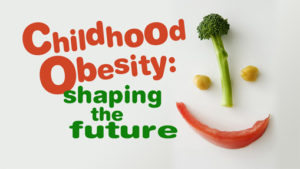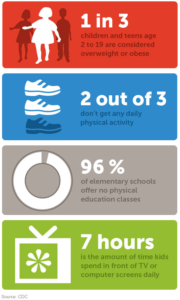It is shown that there are high rates of obesity worldwide which have been attributed to a combination of genetics and environment. Myriad environmental exposures may contribute to obesity, including calorie-rich diets, sedentary behavior, stress, and overuse of antibiotics. Just as important as the types of exposures is the timing. The period from conception to adolescence is known to be especially sensitive to obesity risks influenced by maternal fitness and childhood diet and physical activity. Parental experiences and fitness before conception, generational effects, and early-life events can also affect adult health.
The “CDC-Centers for disease control and prevention” have obesity facts they present as follows:
- “Childhood obesity has more than doubled in children and quadrupled in adolescents in the past 30 years.
- The prevalence of obesity was 18.5% and affected about 13.7 million children and adolescents.
- The percentage of children aged 6–11 years in the United States who were obese increased from 7% in 1980 to nearly 18% in 2012, now 18.4%. Similarly, the percentage of adolescents aged 12–19 years who were obese increased from 5% to nearly 21% over the same period, now is 20.6%.
- In 2012, more than one third of children and adolescents were overweight or obese.
- Overweight is defined as having excess body weight for a particular height from fat, muscle, bone, water, or a combination of these factors.
- Obesity is defined as having excess body fat.
- Overweight and obesity are the result of “caloric imbalance”—too few calories expended for the amount of calories consumed—and are affected by various genetic, behavioral, and environmental factors.”
WEB M.D. states “One third of children in the U. S. is overweight or obese, and this number is continuing to rise. Children have fewer weight-related health and medical problems than adults. However, overweight children are at high risk of becoming overweight adolescents and adults, placing them at risk of developing chronic diseases such as heart disease and diabetes later in life. They are also more prone to develop stress, sadness, and low self-esteem.
Children become overweight and obese for a variety of reasons. The most common causes are genetic factors, lack of physical activity, unhealthy eating patterns, or a combination of these factors. Only in rare cases is being overweight caused by a medical condition such as a hormonal problem. A physical exam and some blood tests can rule out the possibility of a medical condition as the cause for obesity.
Although weight problems run in families, not all children with a family history of obesity will be overweight. Children whose parents or brothers or sisters are overweight may be at an increased risk of becoming overweight themselves, but this can be linked to shared family behaviors such as eating and activity habits.
A child’s total diet and activity level play an important role in determining a child’s weight. Today, many children spend a lot time being inactive. For example, the average child spends approximately four hours each day watching television. As computers and video games become increasingly popular, the number of hours of inactivity may increase.”
The effects of childhood obesity impact a short time (if handled quick enough and obesity resolved) as opposed to a long lifetime of obesity. Childhood obesity has both immediate and long-term effects on a person’s health and well-being.
Presently by CDC, they state in this topic the following:
Childhood obesity is a serious problem in the United States putting children and adolescents at risk for poor health. Obesity prevalence among children and adolescents is still too high.
For children and adolescents aged 2-19 years1:
- Hispanics (25.8%) and non-Hispanic blacks (22.0%) had higher obesity prevalence than non-Hispanic whites (14.1%).
- Non-Hispanic Asians (11.0%) had lower obesity prevalence than non-Hispanic blacks and Hispanics.
Here are childhood effects that can occur:
- Obese youth are more likely to have risk factors for cardiovascular disease, such as high cholesterol or high blood pressure. In a population-based sample of 5- to 17-year-olds, 70% of obese youth had at least one risk factor for cardiovascular disease versus if one of your parents has cardiac disease one out of a 4 children family are at risk of getting it (25%) just based on the parents history.
- Obese adolescents are more likely to have pre-diabetes, a condition in which blood glucose levels indicate a high risk for development of diabetes.
- Children and adolescents who are obese are at greater risk for bone and joint problems, sleep apnea, and social and psychological problems such as stigmatization and poor self-esteem.
Long-term health effects that can occur:
- Children and adolescents who are obese are likely to be obese as adults and are therefore more at risk for adult health problems such as heart disease, type 2 diabetes, stroke, several types of cancer, and osteoarthritis. One study showed that children who became obese as early as age 2 were more likely to be obese as adults. Overweight and obesity are associated with increased risk for many types of cancer, including cancer of the breast, colon, endometrium, esophagus, kidney, pancreas, gall bladder, thyroid, ovary, cervix, and prostate, as well as multiple myeloma and Hodgkin’s lymphoma.
- One of the best strategies to reduce childhood obesity is to improve the diet and exercise habits of your entire family. Treating and preventing childhood obesity helps protect the health of your child now and in the future.
The KEY to stopping childhood obesity into adulthood from is through Prevention (which starts in childhood):
- Healthy lifestyle habits, including healthy eating and physical activity, can lower the risk of becoming obese and developing related diseases.
- The dietary and physical activity behaviors of children and adolescents are influenced by many sectors of society, including families, communities, schools, child care settings, medical care providers, faith-based institutions, government agencies, the media, and the food and beverage industries and entertainment industries.
- Schools play a particularly critical role by establishing a safe and supportive environment with policies and practices that support healthy behaviors. Schools also provide opportunities for students to learn about and practice healthy eating and physical activity behaviors.
To prevent obesity and overweight in children we need our communities throughout the world to:
- Promote improvements to the nutritional value of the food children eat in schools, child care centers and after-school programs.
- Support increasing children’s physical activity through improved compliance with physical education mandates by New York City schools, as well as through making physical activities available in after-school programs and City parks and playgrounds.
- To increase education for children and parents about good nutrition, why healthy food choices are important, and how to combat obesity.
- To support efforts that help all in every state of America and in the world making healthy food choices, such as laws eliminating trans-fats, and policies to tax or limit the sizes of sugary beverages. Which has already started in many areas but we need to keep doing it and making it stronger for the children health now in their future.



